Introduction
TeMoji (Japanese: 手文字 te-moji; JSL/TeMoji: 立て下蛇も) is a writing system I created—and am still actively developing—for Japanese Sign Language (JSL; Japanese: 日本手話 Nihon-shuwa; JSL/TeMoji: 分ふもゝ回そゝ). It uses a combination of extended hiragana to encode basic handshapes and orientations, a set of kanji to represent place of articulation, movement, and non-manual markers, and katakana and the English alphabet to denote fingerspelling. The main motivation behind TeMoji is to support learning. Constantly relying on videos to review signs isn’t always practical, and it’s also nice to be able to journal or jot things down in a language as a form of practice that doesn’t require active speaking—or in this case, signing. This is especially helpful in public spaces, where signing to yourself might draw unwanted attention.
A few important caveats before diving into the details:
- I’m not a native signer of JSL or any other sign language, nor am I fluent in any SL.
- JSL, like other sign languages, is highly complex and difficult to analyze phonetically or phonemically, with significant regional and individual variation.
- TeMoji is designed primarily for practical use—making it easier to learn, take notes, or remember signs—not as a formal or comprehensive notation system.
- This is not intended to be a precise phonetic transcription. Rather, it’s a “good enough” phonemic system that seeks to encode enough information for the sign to be recognizable and to be easily typeable using a standard Japanese keyboard.
- Given the previous points, there is naturally no “correct” spelling of signs in TeMoji. All components are optional and primarily dependent on what phonetic information is prioritized by users for recording and recognizing the sign in written form. The bare minimum requirement for spelling in TeMoji is a sign must contain (1) the tegana that underpin the sign, (2) at least one kanji, and (3) whatever additional components necessary for making the sign recognizeable given the context.
One more note: This is the third iteration of TeMoji that I’ve developed. The first version was extremely precise, but that precision came with a lot of problems. It was difficult to use, relying heavily on obscure characters and Unicode far beyond standard Japanese. I also struggled with deciding on how to represent many signs, since signers often show considerable variation across multiple phonetic parameters (and I was also much more uncertain with what was phonemically most important at that time). The second version made significant improvements by prioritizing phonemicity over phonetic precision (after building a little bit of intuition) and limiting the character set to just kanji and kana. However, that version made extensive use of dakuten and handakuten to mark palm orientation, which became inconvenient to type when applied to kana that don’t have standard dakuten or handakuten forms. The current version prioritizes useability (i.e., typeability and readability) above all else, while simultaneously allowing for some flexibility in the precision of transcription.
As a demonstration of the flexibility of TeMoji, here are two possible ways of writing the JSL sign for “thank you,” one using a very broad (more phonemic) approach and the other using a very narrow (more phonetic) approach:

Broad TeMoji Transcription
節首て
Literally: Move the TE handshape from the back (knuckles) of the non-dominant hand to the chin/neck area.
Narrow TeMoji Transcription
(感謝)天節首立てっ土平て㋐
Literally: Move the TE handshape, oriented with fingers point upwards, from the upper part of the torso to the back (knuckles) of the non-dominant hand, positioned at the lower part of the torso and oriented with fingers pointing to ones side, then back up to the chin/neck area, all while opening ones mouth in an /a/ shape, and with the intended meaning of THANKS.
Handshapes and Orientation
Handshapes are encoded in TeMoji using hiragana or “tegana” (手仮名), based somewhat on the standard handshapes associated with each character in fingerspelling. Tegana can be split into two categories: uragana (裏仮名), where the palm faces away from the signer (either outwards or downwards), and fushigana (節仮名), where the knuckles face away from the signer (either outwards or downwards). Fushigana are generally derived by adding a dakuten or handakuten to the uragana. The following table outlines tegana and their associated handshapes in tate (立) orientation.
| Uragana (裏仮名) | ||||
| あ A | い I | う U | え E | お O |
 |  |  |  |  |
| か KA | き KI | く KU | け KE | こ KO |
 |  |  | 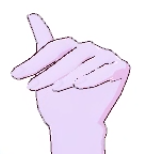 |
|
| さ SA | し SI | す SU | せ SE | そ SO |
 |  |  |  |
|
| た TA | ち TI | つ TU | て TE | と TO |
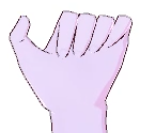 |  |  |  |  |
| な NA | に NI | ぬ NU | ね NE | の NO |
 |  |  |  |
|
| は HA | ひ HI | ふ HU | へ HE | ほ HO |
 | 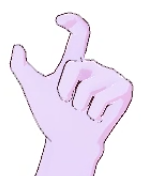 |  |  |  |
| ま MA | み MI | む MU | め ME | も MO |
 |  |  |  |
|
| Fushigana (節名節) | ||||
| わ WA | ゐ WI | ゔ VU | ゑ WE | を WO |
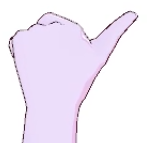 |  |  |  |  |
| が GA | ぎ GI | ぐ GU | げ GE | ご GO |
 | 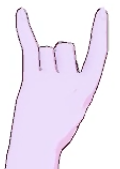 |  |  |  |
| ざ ZA | じ ZI | ず ZU | ぜ ZE | ぞ ZO |
 | 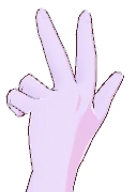 | 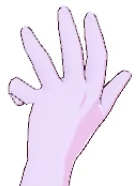 |  |  |
| だ DA | ぢ DI | づ DU | で DE | ど DO |
 |  | 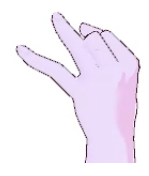 |  |  |
| ら RA | り RI | る RU | れ RE | ろ RO |
 |  |  |
||
| ば BA | び BI | ぶ BU | べ BE | ぼ BO |
 |  |  |  |  |
| ぱ PA | ぴ PI | ぷ PU | ぺ PE | ぽ PO |
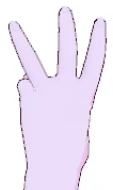 | 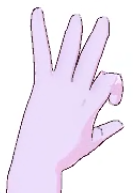 |  |  |
|
| Functional Graphemes | ||||
| っ SOKU (separates unique secondary hand articulations) |
||||
| ゝ DOU (indicates handshapes mirrored by secondary hand) |
||||
| ー TYOU (indicates repeated transitions between handshapes) |
||||
Each tegana has four possible orientations: tate (立), hira (平), soto (外), and uchi (内). Tate orientation denotes when the fingers or knuckles (if fingers are closed) point upwards, hira orientation denotes when the fingers or knuckles point to ones side, soto orientation denotes when the fingers or knuckles point outwards away from the signer, and uchi orientation denotes when the fingers or knuckles point inwards towards the signer. A tegana can never appear on its own and must always follow at least one kanji, the most basic being the orientation kanji (however, these can be dropped if other kanji are present). The following table outlines the orientations along with examples using the uragana て (TE) and its fushigana counterpart で (DE).
| 立 (TATE) | 平 (HIRA) | 外 (SOTO) | 内 (UTI) |
|
| て (TE) | 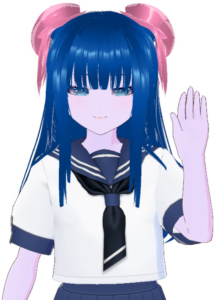 | 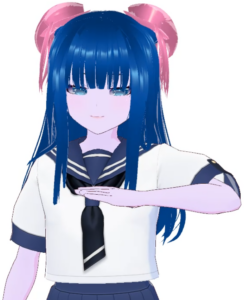 | 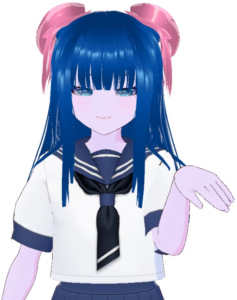 | 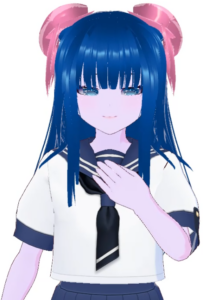 |
| 立て (TATE-TE) | 平て (HIRA-TE) | 外て (SOTO-TE) | 内て (UTI-TE) |
|
| で (DE) | 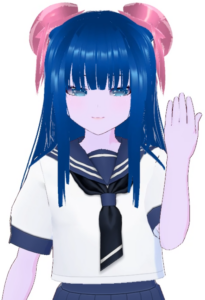 | 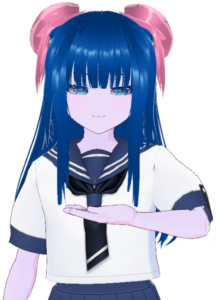 | 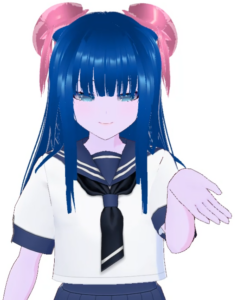 | 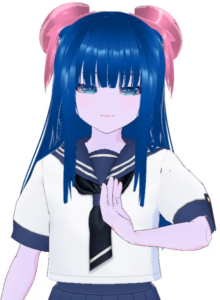 |
| 立で (TATE-DE) | 平で (HIRA-DE) | 外で (SOTO-DE) | 内で (UTI-DE) |
To indicate a transition in handshape within the same sign, the tegana for the second handshape is simply placed after the tegana for the first handshape. To indicate a repeated transition between handshapes, the chōonpu ー is placed after the string of tegana. The odorijiゝ is used to indicate when the secondary hand mirrors the dominant hand. Finally, the sokuonfu っ is used to separate simultaneous unique secondary hand articulations from the dominant hand articulations.
| Transition | Repetition | Mirroring | Simultaneity |
 |  |  |  |
| 出えお (DASE-E-O) GO.HOME | 外ぶぽゝー (SOTO-BU-PO-DOU-TYOU) SAME | 合ひゝ (AWASE-HI-DOU) MEET | 平ふぶっぶふ (HIRA-FU-BU-SOKU-BU-FU) NOT.BE / DIFFER |
Place of Articulation
Place of articulation refers to the places of the body where a handshape either transitions or moves. TeMoji does not distinguish the left side of the body from the right side of the body, except for places associated with the torso. With regards to the torso places, NITI (日) and HI (火) correspond to the side of the ones dominant hand, while TUKI (月) and MIZU (水) correspond to the side of ones non-dominant hand. The arm places are primarily associated with the non-dominant hand, where the dominant hand’s handshape is articulated on or around the non-dominant hand/arm. The table below outlines the most basic kanji for places of articulation in TeMoji:
| 角 TUNO horn/temple | 木 KI forehead/top | 角 TUNO horn/temple |
|||||
| 眉 MAYU eyebrow | 眉 MAYU eyebrow |
||||||
| 目 ME eye | 目 ME eye |
||||||
| 耳 MIMI ear | 田 TA cheek | 中 NAKA nose/center | 田 TA cheek | 耳 MIMI ear |
|||
| 牙 KIBA teeth |
|||||||
| 本 MOTO jaw | 口 KUTI mouth/lips | 本 MOTO jaw |
|||||
| 舌 SITA tongue |
|||||||
| 首 KUBI neck/chin |
|||||||
| 肩 KATA shoulder | 日 NITI upper dominant | 天 AMA center chest | 月 TUKI upper inferior | 肩 KATA shoulder |
|||
| 肘 HIZI upperarm/elbow | 肘 HIZI upperarm/elbow |
||||||
| 腕 UDE forearm/wrist | 火 HI lower dominant | 土 TUTI center abdomen | 水 MIZU lower inferior | 腕 UDE forearm/wrist |
|||
| 裏 URA palm | 裏 URA palm |
||||||
| 節 HUSI knuckles | 節 HUSI knuckles |
||||||
| 足 ASI leg | 足 ASI leg |
||||||
Below, I also provide a diagram showing roughly where the articulations correspond to my own body. It should be noted, that this list of place kanji is not extensive, and other kanji may be used depending on the sign and context. For example, to refer to clothing, a JSL signer typically pinches or points to their shirt, in which case the kanji 服 (HUKU) meaning “clothing” may be used for place. Similarly, the JSL signs for hair and the color black typically involve touching or pinching ones hair, in which case the kanji 髪 (KAMI) could be used.
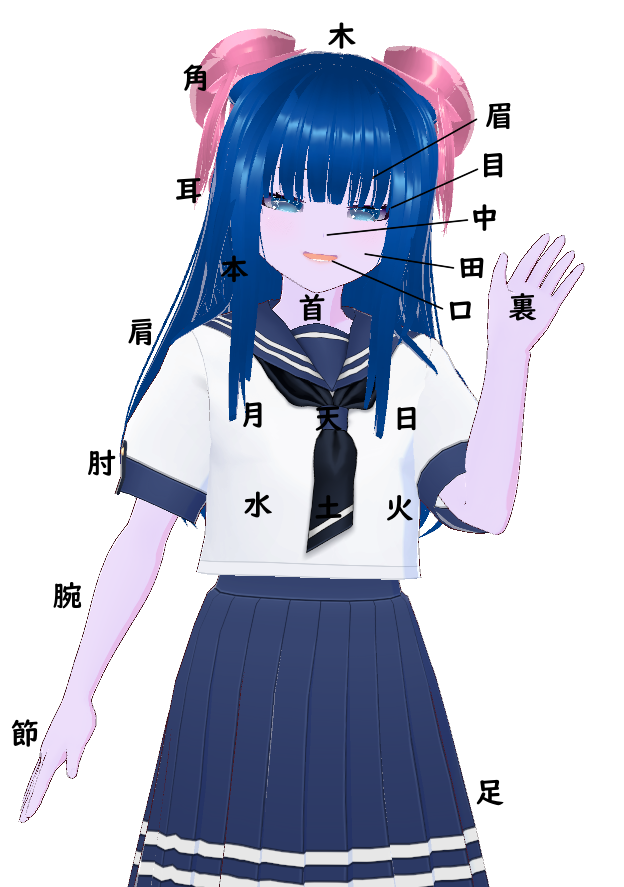
Movement
Movements, excluding those resulting from handshape transitions, are also encoded through kanji. If the movement results from a change in place of articulation, then it is encoded by writing the two place kanji next to each other. If the movement does not result form a change in place, then a unique kanji may be used to denote the movement. The kanji odoriji 々 is used when a movement is repeated or iterated. The odoriji is always placed after the kanji encoding the iterated movements. Additionally, the wave dash ~ can be used to indicate a drawn out or exaggerated motion as is typically placed after the handshape components. The table below is a non-exhaustive list of some of the most common movement kanji.
| Kanji | Gloss | Description | Example |
| 出 | DASE | outward, away from the signer |  出えお GO.HOME |
| 入 | IRE | inward, towards the signer |  入えお COME.HOME |
| 上 | AGARE | upwards |  上立ふゝ EAST |
| 下 | KUDARE | downwards |  下々外ねゝ RAIN |
| 合 | AWASE | bringing together |  合ひゝ MEET |
| 分 | WAKE | pulling apart |  分ふもゝ JAPAN |
| 回 | MAWARE | spinning or turning |  回そゝ SIGN.LANGUAGE |
| 踊 | ODORE | side-to-side |  踊そ WHAT |
| 伝 | TUTE | tracing along a surface |  裏伝々め USE |
| 蛇 | HEBI | zigzag or snake pattern |  下蛇めゝ SNOW |
Semagrams and Kanji-derived Signs
Semagrams are optional components that can be used to specify the exact intended meaning of the sign. Semagrams are written as kanji inside parantheses and always precede other TeMoji components. I don’t provide a list here due the vast possibilities of kanji that could be used as semagrams; you can go learn kanji for that. Instead, for an example, you can look at the narrow transcription of “thank you” in the introduction section, where 感謝 (thanks/gratitude) is written in parantheses before the phonetic TeMoji components.
Some signs in JSL, however, are directly borrowed from kanji as iconic imitations of the characters. In such instances, square brackets can be used alongside the kanji. Typically, I also encode the handshapes and movements used to make up the kanji-imitation sign.
| Handshapes | Drawing | Compound |
 |  |  |
| [田]中まっぱ [田] FIELD | [人]中水そ中火そ [人]下々そ [人] PERSON | [入口]中そっそ口回ぞ [入口] ENTRANCE (ENTER+MOUTH) |
Non-Manual Elements
Head Movement
Kanji is also used to represent head movements and are treated as movement kanji. Examples of kanji used for head movement include: 傾 (KASIGE) for tilting ones head to the side, 振 (HURE) for shaking ones head side-to-side, and 頷 (UNAZUKE) for nodding. One example of functional head movement involves differentiating possession from a set of nouns; for example, signing “me” followed by “little sister” can be interpreted either as “me and [my] little sister” or “my little sister”, depending on where one nods. In broader transcriptions, I might just rely on comma placement and punctuation to differentiate such cases.
 |  |
| 内そ頷下い 内そ下い “my little sister” | 頷内そ頷下い 内そ、下い “me and [my] little sister” |
Facial Expressions
Facial expressions can be encoded through the use of emojis. For example, yes/no questions are typically accompanied by raised eyebrows, so the emoji 😯 por 😏 might be used; though, I think this can be implied in broad transcription through the use of a question mark. In some cases, the raising or lowering of eyebrows may effect the meaning or add slight nuance, in which case you might differentiate them as 😯 (raised) and 😟 (lowered). Other facial expressions may be encoded through emojis (for example, the sign for “DIFFICULT/UNABLE.TO” is typically accompanied by a frown and furled eyebrows); although, I typically do not encode these in broad transcriptions.
 |  |
| 傾首出ぶぽ😏 首出ぶぽ? “Do you like it?” | 田もぽ😠 田もぽ! “It’s hard!” / “I can’t do it!” |
Mouthings
Mouthings or mouth shapes can also be encoded through the use of encircled katakana, as detailed in the table below. Each encircled katakana represents the shape that the mouth takes when pronouncing that katakana in Japanese. These are placed at the end of a sign but before emojis, and are usually optional for broader transcription.
| A | I | U | E | O | |
| ∅ | ㋐ /a/ | ㋑ /i/ | ㋒ /u/ | ㋓ /e/ | ㋔ /o/ |
| K | ㋕ /ka/ | ㋖ /ki/ | ㋗ /ku/ | ㋘ /ke/ | ㋙ /ko/ |
| S | ㋚ /sa/ | ㋛ /si/ | ㋜ /su/ | ㋝ /se/ | ㋞ /so/ |
| T | ㋟ /ta/ | ㋠ /ti/ | ㋡ /tu/ | ㋢ /te/ | ㋣ /to/ |
| N | ㋤ /na/ | ㋥ /ni/ | ㋦ /ta/ | ㋧ /ne/ | ㋨ /no/ |
| H | ㋩ /na/ | ㋪ /hi/ | ㋫ /hu/ | ㋬ /he/ | ㋭ /ho/ |
| M | ㋮ /ma/ | ㋯ /mi/ | ㋰ /mu/ | ㋱ /me/ | ㋲ /mo/ |
| Y | ㋳ /ja/ | ㋴ /ju/ | ㋵ /jo/ |
||
| R | ㋶ /ra/ | ㋷ /ri/ | ㋸ /ru/ | ㋹ /re/ | ㋺ /ro/ |
| W | ㋻ /wa/ | ㋾ /wo/ |
Order of Components
The components that make up a written sign in TeMoji are ordered from more broad/abstract components to more fine/concrete components, always ending with tegana, with mouthing characters and emojis optionally added to the end of the string. The following schema outlines the basic ordering of TeMoji components:
Semagram – Place – Movement – Orientation – Handshape – Mouthing – Emoji
Finger Spelling
Finally, katakana is used to represent the standard fingerspelling used for Japanese kana, as detailed in the table below.
| A | I | U | E | O | |
| ∅ | ア a | イ i | ウ u | エ e | オ o |
| K | カ ka | キ ki | ク ku | ケ ke | コ ko |
| S | サ sa | シ si | ス su | セ se | ソ so |
| T | タ ta | チ ti | ツ tu | テ te | ト to |
| N | ナ na | ニ ni | ヌ nu | ネ ne | ノ no |
| H | ハ ha | ヒ hi | フ hu | ヘ he | ホ ho |
| M | マ ma | ミ mi | ム mu | メ me | モ mo |
| Y | ヤ ya | ユ yu | ヨ yo |
||
| R | ラ ra | リ ri | ル ru | レ re | ロ ro |
| W | ワ wa | ヲ wo |
|||
| G | ガ ga | ギ gi | グ gu | ゲ ge | ゴ go |
| Z | ザ za | ジ zi | ズ zu | ゼ ze | ゾ zo |
| D | ダ da | ヂ di | ヅ du | デ de | ド do |
| B | バ ba | ビ bi | ブ bu | ベ be | ボ bo |
| P | パ pa | ピ pi | プ pu | ペ pe | ポ po |
| n | ン n |
||||
| sokuon | ッ (geminate) |
||||
| chōon | ー (long vowel) |
||||
Full-width Latin characters are also used to represent the standard fingerspelling used for Latin characters (and borrowed from ASL).
| A | N | ||
| B | O | ||
| C | P | ||
| D | Q | ||
| E | R | ||
| F | S | ||
| G | T | ||
| H | U | ||
| I | V | ||
| J | W | ||
| K | X | ||
| L | Y | ||
| M | Z |
Kana and full-width Latin characters can replace handshapes or other character combinations and can also be combined with other TeMoji characters. One reason to do this is when representing a sign borrowed from Japanese, using the kana corresponding to the Japanese pronunciation as the base handshape. Similarly, this approach can apply to signs borrowed from ASL, where the Latin letter representing the English spelling or pronunciation is used as the base. Kana can also be used to represent functional particles in signed Japanese, or when such particles are borrowed into JSL or appear in mixed JSL/signed Japanese contexts (this is primarily how I use them in my broad transcriptions).
Example Transcription
Below is my attempt at a broad TeMoji transcription of a native JSL signer, along with a sentence-by-sentence breakdown and linguistic glossing. I want to emphasize that I’m not a native JSL signer and am far from fluent, so my transcription may not be fully accurate or ideal—some features I’ve treated as phonemic might actually be noise, and I may have left out other aspects that a native signer would find important. But either way, this is how I would transcribe it for myself, and this hopefully serves as a good demonstration of the system.
A note on the signer’s style: The signer in this video signs quickly and with a very casual tone. As a result, many of her signs blend together, she often uses only one hand for two-handed (mirrored) signs (sometimes alternating between her dominant and non-dominant hands), and some articulations are slightly imprecise or influenced heavily by neighboring signs. Additionally, she incorporates elements of spoken Japanese, such as using particles like が (appearing to function more as a topic marker than a subject marker), の (used for emphasis or explanation), and mouthing も to convey “also.” In my transcription, I try to strike a balance between her casual style and more “formal” ways of articulating each sign.
耳そ耳下々く踊そ傾耳が?出々耳そっ口そガ、耳立外そ立ねれゝ、分てゝ~合でゝ立ねれ口出そガ、出々でっ入々で田もぽ耳て立てで、口出て?口出てガ耳立外そ立ねれゝノ、分てゝ合で。内そ天入々そ㋲耳下々く内れ、中入内に耳立外そ㋲耳下々く、【拍手】㋲耳下々く。口出てガ立ねれ!踊そ踊ね㋲、踊そ㋲立ねれ!上蛇れ月日で外ぞ🤨?踊そ、回平てガ天入々ほ日水外てゝ踊外く耳下々く伝々べゝ。
| 耳そ | 耳下々く | 踊そ | 傾耳が? |
| ear | cannot.hear | what | feeling? |
“What’s it like to be deaf?”
| 出々耳そっ口そ | ガ、 | 耳立外そ | 立ねれゝ、 | 分てゝ~合でゝ | 立ねれ | 口出そ | ガ、 |
| hearer | ᴛᴏᴘ | sound | not.exist | completely | not.exist | say | ᴛᴏᴘ |
| 出々でっ入々で | 田もぽ | 耳て | 立てで、 | 口出て? | |||
| experience | unable.to | hear | but | for.real |
“I heard that hearing people can’t really experience total silence, like no sound at all—is that true?”
| 口出て | ガ | 耳立外そ | 立ねれゝ | ノ、 | 分てゝ合で。 |
| for.real | ᴛᴏᴘ | sound | not.exist | ᴇxᴘʟ | completely |
“Because I really don’t [experience] sound—like literally none at all.”
| 内そ | 天入々そ-㋲ | 耳下々く | 内れ、 | 中入内に | 耳立外そ-㋲ | 耳下々く、 |
| ɪɴᴅᴇx1 | inside.body-also | cannot.hear | ɪɴᴅᴇx1 | air | sound-also | cannot.hear |
| 【拍手】-㋲ | 耳下々く。 | |||||
| *clapping*-also | cannot.hear |
“I can’t hear the inside of my body, I can’t hear the sound of the air, and this too (clapping)—I can’t hear it.”
| 口出てガ | 立ねれ! | 踊そ-踊ね㋲、 | 踊そ㋲ | 立ねれ! |
| for.real | not.exist | nothing-at.all | nothing | not.exist |
“For real, no cap, I really can’t! Nothing, zip, nada!”
| 上蛇れ | 月日で | 外ぞ-🤨? |
| imagine | able.to | ɪɴᴅᴇx2-Q |
“Can you even imagine that?”
| 踊そ、 | 回平て | ガ | 天入々ほ | 日水外てゝ | 踊外く | 耳下々く | 伝々べゝ。 |
| like | everyone | ᴛᴏᴘ | uneasy | become | extent | cannot.hear | apparently |
“Like, apparently I’m so deaf that it actually freaks people out.”
